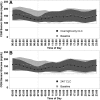Multinational Home Use of Closed-Loop Control Is Safe and Effective
- PMID: 27208316
- PMCID: PMC5876016
- DOI: 10.2337/dc15-2468
Multinational Home Use of Closed-Loop Control Is Safe and Effective
Abstract
Objective: To evaluate the efficacy of a portable, wearable, wireless artificial pancreas system (the Diabetes Assistant [DiAs] running the Unified Safety System) on glucose control at home in overnight-only and 24/7 closed-loop control (CLC) modes in patients with type 1 diabetes.
Research design and methods: At six clinical centers in four countries, 30 participants 18-66 years old with type 1 diabetes (43% female, 96% non-Hispanic white, median type 1 diabetes duration 19 years, median A1C 7.3%) completed the study. The protocol included a 2-week baseline sensor-augmented pump (SAP) period followed by 2 weeks of overnight-only CLC and 2 weeks of 24/7 CLC at home. Glucose control during CLC was compared with the baseline SAP.
Results: Glycemic control parameters for overnight-only CLC were improved during the nighttime period compared with baseline for hypoglycemia (time <70 mg/dL, primary end point median 1.1% vs. 3.0%; P < 0.001), time in target (70-180 mg/dL: 75% vs. 61%; P < 0.001), and glucose variability (coefficient of variation: 30% vs. 36%; P < 0.001). Similar improvements for day/night combined were observed with 24/7 CLC compared with baseline: 1.7% vs. 4.1%, P < 0.001; 73% vs. 65%, P < 0.001; and 34% vs. 38%, P < 0.001, respectively.
Conclusions: CLC running on a smartphone (DiAs) in the home environment was safe and effective. Overnight-only CLC reduced hypoglycemia and increased time in range overnight and increased time in range during the day; 24/7 CLC reduced hypoglycemia and increased time in range both overnight and during the day. Compared with overnight-only CLC, 24/7 CLC provided additional hypoglycemia protection during the day.
Trial registration: ClinicalTrials.gov NCT02137512.
© 2016 by the American Diabetes Association. Readers may use this article as long as the work is properly cited, the use is educational and not for profit, and the work is not altered.
Figures



References
-
- Battelino T, Omladič JS, Phillip M. Closed loop insulin delivery in diabetes. Best Pract Res Clin Endocrinol Metab 2015;29:315–325 - PubMed
-
- Lee SW, Welsh JB. Upcoming devices for diabetes management: the artificial pancreas as the hallmark device. Diabetes Technol Ther 2015;17:538–541 - PubMed
-
- Peyser T, Dassau E, Breton M, Skyler JS. The artificial pancreas: current status and future prospects in the management of diabetes. Ann N Y Acad Sci 2014;1311:102–123 - PubMed
Publication types
MeSH terms
Substances
Associated data
LinkOut - more resources
Full Text Sources
Other Literature Sources
Medical
Miscellaneous

